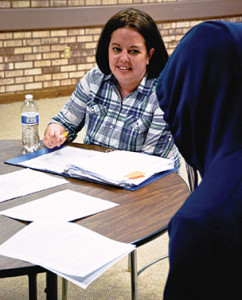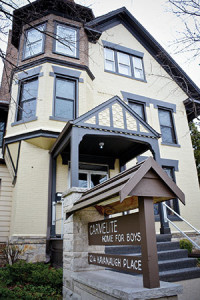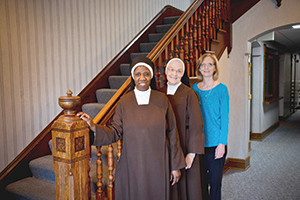For 100 years, the Carmelite Sisters of the Divine Heart of Jesus have quietly cared for disenfranchised young boys on an unassuming residential street near downtown Wauwatosa.

Julie Smith, a social worker at the Carmelite Home for Boys, works with adolescents during a group therapy session, Wednesday, March 30. (Catholic Herald photo by Juan C. Medina)
First looking after toddlers and boys from broken homes, then shifting focus to delinquent adolescents, generations of sisters and their young charges have come and gone in the stately Victorian home on Kavanaugh Place known as the Carmelite Home for Boys.
“It’s the work that we do – we take care of children, the aged and the youth,” said Sr. Immaculata Osterhaus, superior of the Northern Province of the Carmelite Sisters of the Divine Heart of Jesus. “We’re willing to give our life, 24 hours a day if it has to be.”
The property on Kavanaugh Place and its inhabitants are a striking study in what can change over the course of a century, and what can stay the same.
Though the work done by the sisters and those for whom they do it have both undergone transformations; the spirit of that work – care for the vulnerable and a cheerful embrace of suffering – remains unaltered.
Or, in the words of the order’s foundress, Mother Maria Teresa of St. Joseph: “See God in all, serve God in all, and love God in all.”
Order came to Wisconsin in 1912
Mother Maria, a native of Germany, brought the Carmelite Sisters of the Divine Heart of Jesus to North America in 1912, intending to open a home for toddlers and babies displaced by divorce and poverty.
When the sisters quickly outgrew their first home in Milwaukee and set out to find another

The Carmelite Home for Boys has been located at 1214 Kavanaugh Place, Wauwatosa, since 1916.
one, Mother Maria had a vision of a front hall with a grand staircase. When she visited the home at 1214 Kavanaugh Place in Wauwatosa, the first thing she noticed was its beautiful staircase – the exact one from her vision, she said. The Carmelite Home for Boys moved there in 1916. A building was added to the original house in the 1930s to meet increasing space needs.
At its height, said Sr. Immaculata, the home housed 70 children whose parents were paying $12-$15 per month for their care. The sisters also ran a home for girls in West Allis, St. Joseph’s Home on Lincoln Avenue, where many of the boys’ sisters resided.
In 1967, the Wauwatosa home became a treatment center for adolescent boys from the County Welfare Department. That change was instigated by the fact that there were fewer boys from broken homes who needed such an institution – divorce had become more common, and children were less often displaced by it.
Home provides compassion, guidance
Today, the majority of the Carmelite Home’s clients are African-American, between the [su_pullquote align=”right”]If you go An art auction to benefit the Carmelite Home for Boys Saturday, April 30, 7 p.m. Carmelite Home 1214 Kavanaugh Place, Wauwatosa, Cost: $25. Tickets: (262) 227-3954 or tgh@wi.rr.com[/su_pullquote]ages of 11 and 17, and are court-ordered into the program. Though the sisters run the home and interact with the boys, they are mostly ministered to by one of the 15 full- or part-time lay employees and social workers. But their care remains true to the vision of Mother Maria, whose statue is given a place of honor in the home’s front room.
“Mother Foundress, she wanted our building’s home for the children not to be institutional, to be family-style,” said Sr. Immaculata.
The boys’ length of stay at the house is between 90 and 100 days, during which time they undergo a psycho-social evaluation and ensuing treatment plan, participating in individualized and group therapy. The boys also attend school in the home from 8:30 a.m. to 2:30 p.m., and are allowed to go on supervised excursions, but otherwise cannot leave the home. Family visits are allowed, but are often rare.
“Every family is different,” said director Denise Bates. “Some families don’t (visit), and some boys don’t get home for a long time because there’s a lot of dysfunction in the homes.”
So it often falls within the purview of the Carmelite Home to provide compassionate guidance in the young men’s lives.
“There are some youth workers that are working here that have experienced the same kind of lifestyles they have, so they have a lot to offer and they can help provide the direction they need,” said Bates. “We try to make it as comfortable as possible, and I think the connections with people make a big difference, and the compassion that they see in the people helping them, even though they might scream and holler at them, call names, I think they still appreciate the people caring for them.”
A bond of suffering
Mother Maria is known to have said that “there is everything in heaven except suffering; hence, we cannot have enough of it here on earth.” Fittingly, the inhabitants of the home she founded have never been strangers to suffering, whether they come from a broken home or from a life of crime.

Sr. Immaculata Osterhaus and Sr. Maria Goretti Ifeorah, Carmelite Sisters of the Divine Heart of Jesus, and Denise Bates, director of the Carmelite Home for Boys, stand by the staircase the order’s foundress, Mother Maria Theresa of St. Joseph, saw in a vision when she was seeking a place to relocate the home in 1916. Sr. Immaculata is superior of the order’s Northern Province; Sr. Maria Goretti is administrator of the home.
Today, most of the residents at the Carmelite Home have committed a crime, usually a property offense. Most are referred through Wraparound Milwaukee, an initiative of the Milwaukee County Behavioral Health Division, which aims to reduce institutionalization for young people.
Administrator Sr. Maria Goretti has been living at the motherhouse since 2002. Prior to coming to Wauwatosa, the Nigerian native worked at a similar Carmelite home in Italy, but said the American boys are much more “aggressive.”
“Here, a sister cannot be with them without having a male staff member be with them. They are aggressive,” she said. The sisters do sometimes share meals with the boys and celebrate holidays with them.
“And yet there’s that other side of them that you just fall in love with and you try to help,” said Bates. “The behaviors that they’re demonstrating are learned behaviors, and if you can try to redirect them and teach them new skills, you’ve made some progress.”
“Some of them, they don’t want to leave when it’s time to leave, because they know what they are going to face when they leave here,” said Sr. Maria Goretti.
The boys that lived in the home in decades past, before it was a treatment center, have fond memories of their time there, said Sr. Immaculata. Many went on to become successful businessmen, lawyers and even priests, she said, adding that every year the sisters host a reunion for former residents.
“They come back with their grandkids, and they take a tour through the home and reminisce,” she said. “They were brothers together.”
In the old days, too, she said, the nuns provided functionality when there was none in the young men’s lives.
“Some of the stories that the sisters could tell, years ago – one boy, he said he always waited to get home from school because when he got home, in the cold winter days, Sister always had a cup of hot chocolate ready for him. He couldn’t wait to get home to that cup of hot chocolate,” she said. “One boy, he told us, they made a stool in the shop here, and he brought it home to his mom; she broke it into pieces for firewood. That was so heartrending for him.”
Gaining exposure to religion
Most of the current residents of the Carmelite Home come from non-religious

Willie Stovall, a social worker at the Carmelite Home for Boys, listens during a meeting with a client at the home. (Catholic Herald photos by Juan C. Medina)
backgrounds and have never seen a nun.
Decades ago, the boys would be taken to Mass weekly, and even as recently as 15 years ago, they would attend liturgies at St. Martin de Porres on Burleigh Street. But too many of the boys complained to their social workers that they were not Catholic and had no interest in attending Mass.
“That’s one of the first questions we ask them – do you have a religion? They look at you like you’re asking a dumb question – ‘What is that?’” said Bates.
In the midst of the boys’ religious indifference, the sisters who live next door at the provincial motherhouse wear the traditional Carmelite habit, and pray the Divine Office together throughout every day. Quipped Sr. Immaculata: “We take prayer breaks, not coffee breaks.”
“That’s where we get our strength,” said Sr. Maria Goretti.
The convent next door was built in the 1950s and serves as the order’s formation house, where women between the ages of 18 and 30 begin their life as Carmelites, moving through the stages of postulancy, novitiate and juniorate.
Seven sisters live at the house, three of whom work in the Carmelite Home for Boys. The order runs houses similar to the Carmelite Home for Boys across the country and even the world, including the St. Joseph’s Home and Rehabilitation Center in Kenosha and the Carmelite Home/Holy Innocents Center in East Chicago, Indiana.
Whatever their age or background, all Carmelite Sisters of the Divine Heart of Jesus are inspired by the life of sacrifice and charity of their “mother foundress,” who was beatified in 2006.
“We fall in love with Mother Foundress and the work that she did,” said Sr. Immaculata. “We read her book (her autobiography ‘The Servant of God’), and we know what she’s all about and we want to follow in her steps.”
